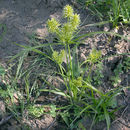Comments
provided by eFloras
Cyperus strigosus is usually among the more common Cyperus species throughout its range. Small individuals flowering the first year may be difficult to distinguish from C. polystachyos, C. odoratus, C. erythrorhizos, and C. esculentus, which may be sympatric. Cyperus strigosus has trigonous achenes and three stigmas, unlike C. polystachyos; C. strigosus has flattened spikelets, unlike the subcylindric ones of C. odoratus; C. strigosus has floral scales usually 3 mm or more, unlike the smaller (1.2–1.5 mm) ones of C. erythrorhizos; C. strigosus has deciduous floral scales and a cormlike stem base with stolons, unlike C. esculentus.
Cyperus strigosus appears to be closely related to the neotropical C. camphoratus Liebmann; both species have deciduous floral scales and deciduous spikelets (G. C. Tucker 1994). Plants segregated as C. stenolepis cannot be distinguished consistently from C. strigosus on any single charcter, rather they appear to be merely large individuals of C. strigosus with long floral scales and frequently septate inflorescence bracts (M. L. Horvat 1941).
- license
- cc-by-nc-sa-3.0
- copyright
- Missouri Botanical Garden, 4344 Shaw Boulevard, St. Louis, MO, 63110 USA
Description
provided by eFloras
Herbs, perennial (often flowering first year), rhizomatous. Culms basally swollen and cormlike, trigonous, (1–)20–40(–90) cm × 1–6 mm, glabrous or few prickles subapically. Leaves flat, (10–)20–40 cm × 1–4(–8) mm, margins and midribs glabrous or scabridulous. Inflorescences: spikes 1–4, loosely ovoid to oblong-cylindric; (6–)10–28(–50) × 10–40 mm; rays sometimes absent, usually (1–)3–6(–8), 0.5–7(–25) cm; if absent, inflorescence a congested head; 2d order rays sometimes present, 1–4(–9) cm; rachis 8–18(–25) mm; bracts (3–)5–7(–10), ascending at 30–45°, cross ribs sometimes conspicuous, (1–)10–30(–45) cm × (1–)2–4(–12) mm; rachilla ± deciduous, wings 0.4–0.5 mm wide. Spikelets (5–)12–50, linear-lanceoloid, compressed, 5–30 × 0.6–0.9 mm; floral scales ± deciduous, 3–11, appressed, medially green, laterally stramineous to pale brown, 3–4-ribbed laterally, (1–)3-ribbed medially, oblong-obovate, 3.2–4.5(–6) × 1–1.8 mm, apex ± acute, overlapping lower 1/4–1/2 of next scale. Flowers: anthers 0.3–0.5 mm; styles 1–2 mm; stigmas 3–4 mm. Achenes purplish brown, ± stipitate, narrowly oblong, (1.5–)1.8–2.4 × 0.5–0.6 mm, apex apiculate, acute, surfaces puncticulate.
- license
- cc-by-nc-sa-3.0
- copyright
- Missouri Botanical Garden, 4344 Shaw Boulevard, St. Louis, MO, 63110 USA
Distribution
provided by eFloras
Man., Ont., Que., Sask.; Ala., Ariz., Ark., Calif., Colo., Conn., Del., D.C., Fla., Ga., Idaho, Ill., Ind., Iowa, Kans., Ky., La., Maine, Md., Mass., Mich., Minn., Miss., Mo., Nebr., Nev., N.H., N.J., N.Mex., N.Y., N.C., Ohio, Okla., Oreg., Pa., R.I., S.C., S.Dak., Tenn., Tex., Utah, Vt., Va., Wash., W.Va., Wis.
- license
- cc-by-nc-sa-3.0
- copyright
- Missouri Botanical Garden, 4344 Shaw Boulevard, St. Louis, MO, 63110 USA
Habitat
provided by eFloras
Pond shores, ditches, damp, disturbed soils, sometimes weeds of gardens or croplands; 0–1500m.
- license
- cc-by-nc-sa-3.0
- copyright
- Missouri Botanical Garden, 4344 Shaw Boulevard, St. Louis, MO, 63110 USA
Synonym
provided by eFloras
Cyperus hansenii Britton; C. stenolepis Torrey; C. strigosus var. hansenii (Britton) Kükenthal; C. strigosus var. stenolepis (Torrey) Kükenthal; Mariscus stenolepis (Torrey) C. B. Clarke; M. strigosus (Linnaeus) C. B. Clarke
- license
- cc-by-nc-sa-3.0
- copyright
- Missouri Botanical Garden, 4344 Shaw Boulevard, St. Louis, MO, 63110 USA
Cyperus strigosus: Brief Summary
provided by wikipedia EN
Cyperus strigosus is a species of sedge known by the common names false nutsedge and straw-colored flatsedge. It is native to the United States, Cuba and Canada, where it grows in wet areas in many habitat types, including disturbed and cultivated areas such as roadsides and crop fields. It is common and sometimes weedy. It is a perennial sedge growing up to 70 centimetres tall. The inflorescence is a cluster of many linear-shaped spikelets up to 3 centimetres long each. A few long, leaf-like bracts grow at the base of the spike.
Introduced populations occur in Bulgaria, France, Italy, Spain and Bangladesh.
- license
- cc-by-sa-3.0
- copyright
- Wikipedia authors and editors

